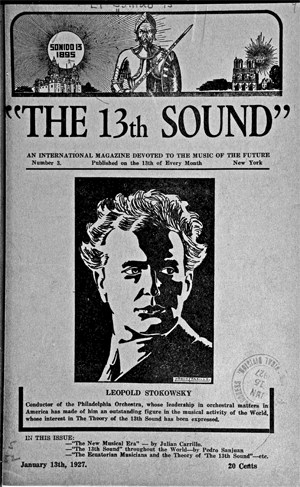El Sonido 13
Includes:
Prepared by Gabriel Caballero
Online only (2021)

The music journal El Sonido 13 [The 13th Sound] was published in Mexico City on a monthly basis in its first year (1924) and a fortnightly basis in its second year (1925). A single American issue was published in New York City in the autumn of 1926. Three further monthly issues, written in English with Spanish translation, followed in 1926 and one on 13 January 1927. Bibliographical sources indicate that publication continued on a monthly basis from 1928-31 in San Luis Potosí and with two issues in Mexico (1956), however, only copies of issues from 1928 and 1931 could be located. The first issue of eight pages was followed by issues that are between twenty and thirty pages in length. In general all are printed in two-column format and the page numbering of each issue begins with the number 1. Pages with advertisements are not numbered. The cover pages, in addition to displaying the image of Don Quixote and the slogan “Lucharé por los nobles fueros del arte musical” [I shall fight for the noble charters of musical art], often contain images related to the main article of the issue. The issues from the third volume were published by the All American Press in New York City. The editor was Julián Carrillo, violinist, composer and conductor, and advocate of the division of sound beyond the limits of the scale of twelve semitones. Geronimo Baqueiro Foster, one of Carrillo’s disciples and the journal’s administrator until December 1924, is often a contributing author.
The journal’s focal point is Julian Carrillo’s controversial and revolutionary theory of the “13th sound.” Its conception, as well as the highlights in Carrillo’s musical career, are extensively documented and discussed in the journal. Among the latter include his initial studies in his native town of Ahualulco with Flavio C. Carlos and later studies in composition (with Melesio Morales), violin, and acoustics at the National Conservatory. Carrillo’s national and international achievements as a conductor and violinist are discussed. The formation and pedagogical activities of the ‘Grupo de los 13’ (a group consisting of Carrillo’s disciples), the challenging opinions of those who were skeptical of this theory, and the supportive arguments of its adherents are the principal subjects of some of the articles. It is worth noting that, although not extensively, the journal provides accounts of women interpreters and composers of microtonal music, such as Maria Ahedo and Elvira Larios.
The number thirteen in the group’s name, as in Carrillo’s theory, refers to the possibility of utilizing more than the twelve pitches of the chromatic scale. To support this possibility and highlight the distinctive qualities of the theory of the thirteenth sound, the journal features critical observations on the writings by theorists such as René Lenormand, André Gedalgue, Émile Durand and Théodore Dubois, and on the work in acoustics by the German physicist, Hermann von Helmholtz. A discussion of the anatomy of the human ear and its capability of discerning microtones also aims to support the idea that an infinite number of sounds can and should be used in musical composition. Descriptions and photographs of the instruments constructed for the performance of music based on Carrillo’s system are found throughout the journal’s run.
El Sonido 13 also deals with a number of topics related to its purpose of being a herald of the musical culture of the North American continent and a promoter of new ways of thinking about and analyzing sound. These include surveys of different systems of notation, with articles on musical writing in ancient China, Egypt, India, and Greece, the ecclesiastical modes and Gregorian chant, and the several systems invented by Arnold Schoenberg, Willi von Möllendorf, and Max Meyer, among others. Articles on Schoenberg, Stravinsky, Alois Hába reflect the journal’s engagement with the work of contemporary composers and theorists who were also deemed revolutionary, while others on Stokowski, Arthur Rubinstein, reflect the journal’s interest on traditional classical music. An extract from a presentation by Sourindro Mohun Tagore on Indian music, and Carrillo’s account of the development of the theory of the 13th sound, also published by The Musical Advance are important. News on the events and musical life in Mexico (particularly events related to the National Conservatory and musical institutions in Mexico City), the United States, and Europe usually appear towards the end of each issue.
The RIPM publication is based on a signed copy dedicated to and stored at the Library of Congress in Washington D.C. The issues from 1928 and 1931 were obtained from the CENIDIM (Centro Nacional de Investigación, Documentación e Información Musical “Carlos Chávez”) in Mexico City. If copies of further issues can be located, these will be included at a later date.
